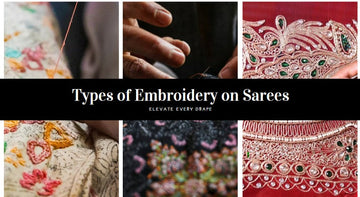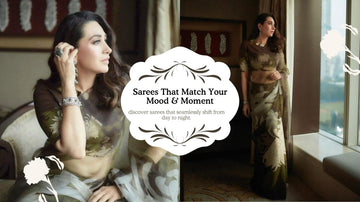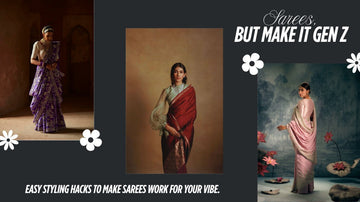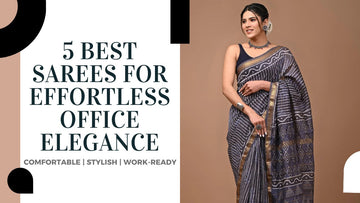Embroidery on Sarees That Elevate Every Drape
The saree is a timeless symbol of elegance and cultural pride, enhanced significantly by intricate embroidery work. Across centuries, different regions of India have perfected their embroidery styles, each narrating the stories of their land, people, and traditions. Today, embroidered sarees are not just fashion statements but timeless investments in art. Let’s delve into the captivating world of embroidery on sarees, highlighting its diverse forms and compelling reasons why they deserve a place in every discerning wardrobe.
Zardozi Embroidery – The Royal Touch of Opulence
Zardozi embroidery is the epitome of regal craftsmanship. Originating from Persia and popularized in India during the Mughal era, this technique utilizes metallic threads of gold and silver, along with pearls, sequins, and beads, to create rich, raised patterns.
Zardozi sarees are perfect for weddings and grand occasions. They embody opulence and sophistication, often enhancing bridal trousseaus and elevating festive celebrations to new heights. When paired with a velvet or silk base, this embroidery transforms the saree into a work of wearable art.
Chikankari – The Elegance of Subtle Craftsmanship
Chikankari is a hand embroidery technique that originated in the royal courts of Lucknow, celebrated for its intricate floral patterns and shadow work. Originally crafted on muslin, this exquisite embroidery technique now elevates a diverse range of fabrics, including georgette, chiffon, and cotton, adding a touch of elegance and sophistication to any garment.
The allure of Chikankari sarees is found in their exquisite, understated elegance, making them a timeless choice for any occasion. Perfect for daytime events, office wear, or summer weddings, they offer a refined, soft look. White-on-white Chikankari is timeless, while colored threads introduce a playful twist.
Kantha – Threads That Tell a Story
Kantha embroidery is a traditional craft from West Bengal and Bangladesh, characterized by its distinctive running stitch technique. It’s more than a decoration—it’s a narrative. These stitches often portray folk tales, animals, flowers, and scenes from everyday village life.
Kantha sarees, crafted from the finest cotton or luxurious tussar silk, embody a unique blend of comfort and cultural heritage. These beautiful garments not only highlight artistic craftsmanship but also represent a significant expression of culture and identity. They’re versatile—ideal for festive gatherings, family events, or even cultural exhibitions where you want to wear a story, not just a style.
Mirror Work – Reflecting India’s Vibrant Spirit
Mirror embroidery, or Shisha work, originated in Gujarat and Rajasthan and reflects the dazzling brightness of Indian festivals. Tiny mirrors are stitched onto fabric using threads, creating intricate geometric and floral designs.
Mirrorwork sarees are a festive favorite. Whether you're dancing at Navratri or attending a mehndi function, they bring sparkle, light, and tradition together in a single ensemble. These sarees are particularly stunning when paired with bright, contrasting blouses and chunky silver jewelry.
Phulkari – Blossoms from Punjab
Meaning “flower work,” Phulkari is a traditional Punjabi embroidery style that involves floral motifs embroidered in vibrant silk threads on coarse cotton fabric. Phulkari sarees, once an essential part of every bride's trousseau in Punjab, now symbolize cultural revival and festive charm.
With their bold designs and cheerful hues, Phulkari sarees are perfect for daytime celebrations or cultural functions. Pair them with juttis and parandas to fully embrace the essence of Punjabi culture.
Kashmiri Kashida – Poetry in Threads
One of the Kashmir Valley's most exquisite needlework traditions is Kashida embroidery. Inspired by the region’s breathtaking landscape, motifs include chinar leaves, birds, flowers, and paisleys, stitched in a single or few colors.
One of the most exquisite needlework designs from the Kashmir Valley is Kashida embroidery. They add warmth without compromising elegance, making them ideal for formal gatherings in colder months.
Aari Embroidery – The Art of Fine Detailing
Aari's work uses a hooked needle and is known for its intricate patterns and bead or sequin embellishments. Originating in Mughal India, Aari is made on silk, velvet, and cotton with motifs like peacocks, florals, and vines.
Aari stitching adds texture and glitter, making it ideal for bridal and party attire. The fine craftsmanship gives the illusion of delicate lace or expensive brocade, making it a favorite among designers.
Gota Patti – Glimmer of Tradition
Gota Patti embroidery is a specialty from Rajasthan in which small pieces of zari ribbon are sewn onto fabric to create intricate patterns. Originally done with gold and silver ribbons, the modern Gota Patti uses synthetic materials for broader accessibility.
It’s a go-to style for weddings and pre-wedding ceremonies, especially for Haldi and Sangeet functions. The glimmering designs on vibrant fabrics create an aura of celebration and joy.
Kutch Embroidery – Tribal Vibrance on Fabric
Kutch embroidery from Gujarat is vibrant, textured, and full of life. Its vivid hues, mirror inlays, and intricate embroidery are frequently influenced by nomadic and tribal customs.
Kutch embroidered sarees offer a boho-chic appeal, perfect for cultural fairs, casual get-togethers, or even fusion styling. When paired with rustic jewelry and Kolhapuri chappals, they exude an unmatched earthy charm.
Thread and Resham Embroidery – Classic and Timeless
Using silk or cotton threads, thread embroidery is a universal technique applied across India. Resham embroidery uses silk threads to create a sheen and sophistication, making it ideal for festive and formal settings.
The elaborate patterns, exquisite stitching, and elegant textures of these sarees make them highly valued. They’re versatile enough to work as office wear, party attire, or traditional celebration outfits.
Stone and Bead Embroidery – Glamour in Every Stitch
For those who want to make a grand entrance, stone and bead embroidery on sarees offer the perfect amount of shimmer and drama. Popular in Bollywood-style sarees, these embellishments are strategically placed to highlight the drape and enhance the silhouette.
Ideal for evening parties, receptions, or red carpet-like events, these sarees ensure you don’t just blend in—you shine out.
Appliqué Embroidery – Craft Meets Innovation
Appliqué work involves stitching smaller pieces of fabric onto a saree to create intricate patterns, often enhanced by threadwork or mirror detailing. States like Odisha and Bihar have rich traditions in this craft, exemplified by the work of Pipli.
These sarees have a textural richness and artistic depth that make them unique conversation starters. Appliqué embroidery suits both ethnic and experimental fashion statements.
Final Thoughts: Embrace the Timeless Beauty of Embroidered Sarees
Embroidery on sarees is not merely decorative—it's a cultural statement, an art form, and a personal legacy. Each thread, stitch, and motif is rooted in centuries-old traditions, yet speaks perfectly to modern sensibilities. Whether you admire subtlety or seek opulence, the variety of embroidered sarees offers something to elevate every wardrobe. Invest in them not just for beauty, but for the stories they carry and the elegance they radiate.









